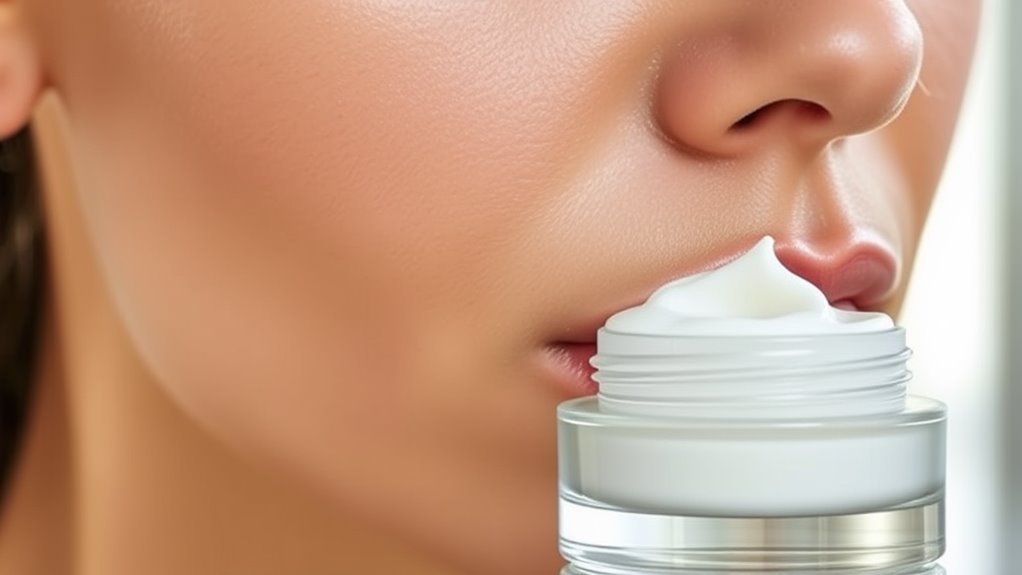How to Tell if Your Moisturizer Is Clogging Your Pores
You might not realize it, but your moisturizer could be clogging your pores. If you’re experiencing breakouts or a greasy feeling after application, it’s time to take a closer look at what you’re using. Understanding how certain ingredients affect your skin is essential. So, how can you tell if your moisturizer is the culprit? Let’s explore the signs and find the right solution for clearer, healthier skin.
Key Takeaways
- Look for frequent breakouts in areas where the moisturizer is applied, indicating potential pore blockage.
- Note any increased oiliness or shine on your skin after using the moisturizer.
- Check for the formation of blackheads or whiteheads, which are signs of clogged pores.
- Pay attention to a heavy or greasy feeling after application, as it may indicate a non-comedogenic formula.
- Monitor for irritation or redness, which can signal negative reactions to pore-clogging ingredients.
Understanding Comedogenic Ingredients
While it might seem like all moisturizers are created equal, understanding comedogenic ingredients can help you choose the right one for your skin. Comedogenic ingredients can lead to clogged pores, causing breakouts.
To master this aspect of skincare, familiarize yourself with common culprits like lanolin, coconut oil, and certain silicones. When selecting a moisturizer, check the ingredient list carefully; look for non-comedogenic labels if you’re prone to acne.
Remember, just because a product is labeled as “natural” doesn’t mean it’s free of potential pore blockers. Embrace minimalism by simplifying your skincare routine to focus on essential, effective ingredients.
Moisturizer tips include opting for lightweight, water-based formulas if you have oily skin. By being proactive and discerning, you can enhance your skincare routine and maintain clear, healthy skin.
Signs Your Moisturizer May Be Clogging Pores
Noticing a few telltale signs can help you determine if your moisturizer is clogging your pores. If you’re experiencing frequent breakouts, especially in areas where you apply moisturizer, it might be time to reassess your product.
Pay attention to increased oiliness or a shiny appearance on your skin; this can indicate that your moisturizer isn’t absorbing properly. You might also notice blackheads or whiteheads forming, which signal clogged pores.
Additionally, if your skin feels heavy or greasy after application, this could mean the product is too rich for your complexion. It’s important to choose non-comedogenic products that are less likely to clog pores.
Finally, irritation or redness may suggest that your skin’s reacting negatively to the ingredients, potentially leading to congestion.
Trust your instincts—your skin will guide you.
How to Identify Your Skin Type
How can you determine your skin type? Start by evaluating how your skin feels throughout the day. Here’s a quick guide to help you identify your skin type:
| Skin Type | Characteristics |
|---|---|
| Oily | Shiny appearance, large pores, prone to acne |
| Dry | Tight, flaky, rough texture, may feel itchy |
| Combination | Oily in the T-zone, dry on cheeks |
Observe your skin after cleansing. If it feels tight or looks dull, you might have dry skin. If it’s shiny, oily, or breaks out, you likely have oily skin. Combination skin varies in different areas. Understanding your skin type is essential for effective skincare choices!
Choosing Non-Comedogenic Moisturizers
Have you ever wondered which moisturizers are best for your skin without causing breakouts? To master your skincare routine, focus on non-comedogenic moisturizers.
These products are specifically formulated not to clog pores, allowing your skin to breathe while providing essential hydration. When shopping, look for labels that state “non-comedogenic,” and avoid heavy oils and waxes that can suffocate your skin.
Ingredients like hyaluronic acid, glycerin, and aloe vera are excellent choices, as they hydrate without overwhelming your pores. Additionally, aloe vera’s healing properties make it a beneficial ingredient for maintaining healthy skin.
Additionally, consider your skin type; gel-based moisturizers work well for oily skin, while cream-based options suit dry skin.
Expert Recommendations for Pore-Friendly Products
When selecting moisturizers that won’t clog your pores, it helps to take into account expert recommendations that prioritize skin health.
Look for lightweight, oil-free formulas containing ingredients like hyaluronic acid and glycerin, which hydrate without overwhelming your skin.
Consider products labeled as “non-comedogenic,” as these are specifically designed to prevent pore blockage.
Experts often recommend botanical extracts, like green tea or chamomile, for their soothing properties and low likelihood of causing breakouts.
Additionally, avoid heavy oils like coconut and mineral oil, which can trap dirt and lead to acne.
Always patch-test new products to gauge your skin’s reaction.
Incorporating essential vitamins into your diet can also enhance your skin’s overall health and glow.
Frequently Asked Questions
Can I Use a Moisturizer With Multiple Ingredients?
Absolutely, you can use a moisturizer with multiple ingredients. Just guarantee that those ingredients suit your skin type and address your specific concerns. Experimenting with combinations can lead to impressive results in your skincare routine.
How Often Should I Change My Moisturizer?
You should change your moisturizer every season or when your skin’s needs shift. Pay attention to how your skin reacts; if it feels dry or irritated, it’s time to explore new formulations that suit you better.
Are Natural Moisturizers Always Non-Comedogenic?
Natural moisturizers aren’t always non-comedogenic. You’ve got to check ingredients carefully; some natural oils can still clog pores. Experimenting with different products helps you find what works best for your skin type and needs.
Does Diet Affect How Moisturizers Impact My Skin?
Yes, your diet greatly impacts your skin’s health. Consuming a balanced diet rich in antioxidants and healthy fats can enhance your skin’s ability to absorb moisturizers effectively, promoting a radiant complexion and reducing potential irritation.
Can Weather Conditions Influence Moisturizer Performance?
Weather conditions impact your skin’s hydration and barrier function. In humid climates, your moisturizer might feel heavier, while dry, cold weather can necessitate richer creams to combat moisture loss. Adjust your products accordingly for ideal performance.

